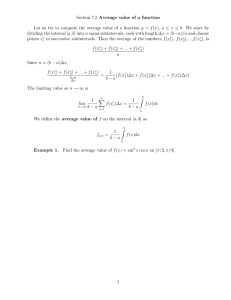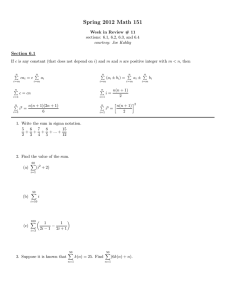Study Guide for Exam 3 Math 1100–4 Z
advertisement
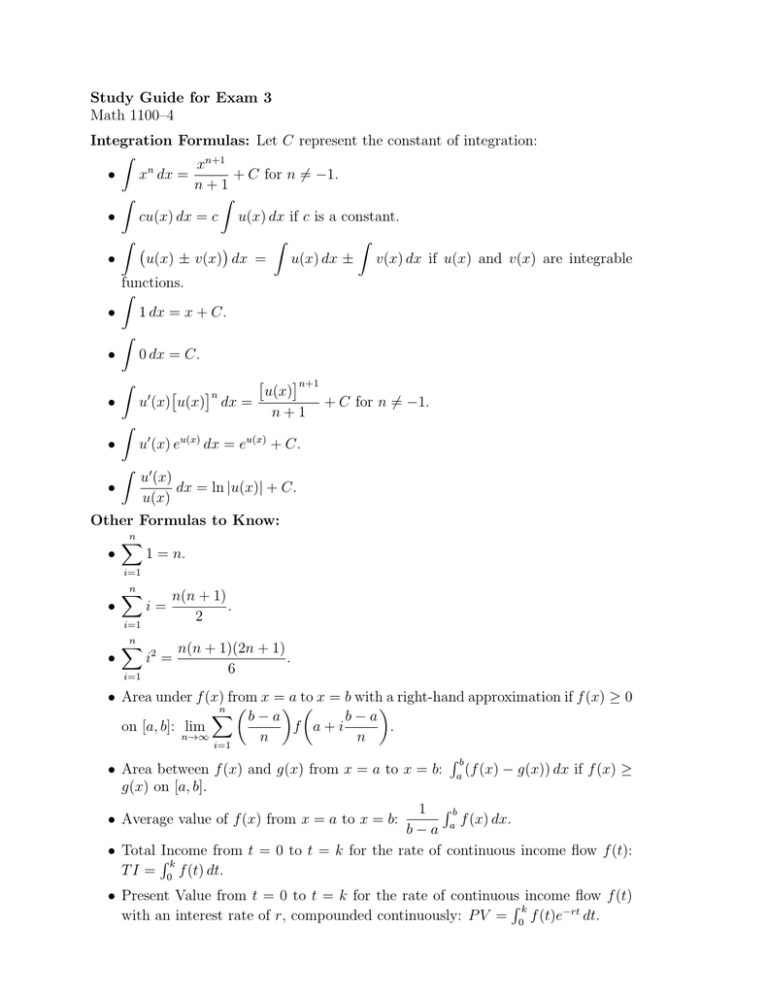
Study Guide for Exam 3 Math 1100–4 Integration Formulas: Let C represent the constant of integration: Z xn+1 + C for n 6= −1. • xn dx = n+1 Z Z • cu(x) dx = c u(x) dx if c is a constant. Z Z Z • u(x) ± v(x) dx = u(x) dx ± v(x) dx if u(x) and v(x) are integrable functions. Z • 1 dx = x + C. Z • 0 dx = C. Z n+1 n u(x) u (x) u(x) dx = + C for n 6= −1. n+1 Z u0 (x) eu(x) dx = eu(x) + C. Z u0 (x) dx = ln |u(x)| + C. u(x) • • • 0 Other Formulas to Know: n X • 1 = n. i=1 • n X i=1 • n X i=1 i= n(n + 1) . 2 i2 = n(n + 1)(2n + 1) . 6 • Area under f (x) from x = a to x = b with a right-hand approximation if f (x) ≥ 0 n X b−a b−a on [a, b]: lim f a+i . n→∞ n n i=1 Rb • Area between f (x) and g(x) from x = a to x = b: a (f (x) − g(x)) dx if f (x) ≥ g(x) on [a, b]. 1 Rb • Average value of f (x) from x = a to x = b: f (x) dx. b−a a • Total Income from t = 0 to t = k for the rate of continuous income flow f (t): Rk T I = 0 f (t) dt. • Present Value from t = 0 to t = k for the rate of continuous income flow f (t) Rk with an interest rate of r, compounded continuously: P V = 0 f (t)e−rt dt. • Future Value from t = 0 to t = k for the rate of continuous income flow f (t) Rk with an interest rate of r, compounded continuously: F V = erk 0 f (t)e−rt dt = erk · P V . R∞ Rb • a f (x) dx = limb→∞ a f (x) dx. Rb Rb • −∞ f (x) dx = lima→−∞ a f (x) dx. Section 12.1 • Know the definition of the (indefinite) integral. • Be able to integrate polynomials, radicals, and fractions if they can be written as the sum of different powers of x, where none of the exponents are −1. Remember to include the “+C.” • Given the marginal revenue function, be able to calculate the Revenue function, using that R(0) = 0. (Note: This does not mean that the constant of integration C = 0, in general.) Section 12.2 • Be able to integrate functions of the form u0 (x)[u(x)]n for n 6= −1, and recognize when to multiply and divide by a constant to make u0 (x) appear within the integral sign. Remember to include the “+C.” Section 12.3 • Be able to integrate exponential functions. Remember to include the “+C.” • Also be able to integrate functions of the form to include the “+C.” u0 (x) u(x) = u0 (x) · [u(x)]−1 . Remember Section 12.4 • When given Marginal Cost, Marginal Revenue, and Marginal Profit functions, be able to find the Cost, Revenue, and Profit functions, respectively. Also be able to calculate the constant of integration C using the given information. Section 13.1 • Be able to interpret and calculate a sum using Sigma notation. • Know how to approximate the area under a curve using a given number of subintervals with a right-hand approximation. • Be able to calculate the exact area under a curve by first approximating it with n rectangles, then taking n → ∞ using a right-hand approximation. Section 13.2 • Be able to calculate definite integrals using the “shortcuts” from this section. • Know how to use the definite integral to interpret word problems when given the instantaneous rate of change of a function, and asked for the exact change of the function on a given interval. Section 13.3 • Be able to find the exact area between two curves on a given interval. • Also be able to find the area bounded between two curves when no interval is given. Recall that this involves finding the x-values where the two curves intersect. • Know how to calculate the average value of a function on a given interval. Section 13.4 • When given a rate of continuous income flow, be able to calculate the Total Income for a given period of time. • When given a rate of continuous income flow and an interest rate with interest that is compounded continuously, be able to calculate the Present Value and Future Value for a given period of time. Section 13.7 • Be able to calculate definite integrals with at least one infinite bound, and determine whether they converge or diverge. Section 14.1 • Be able to evaluate functions of 2 or more variables. • Know how to find the domain of functions of 2 or more variables. Section 14.2 • Be able to find partial derivatives of functions of 2 or more variables. • Know how to calculate second partial derivatives of functions of multiple variables. Sample Problems 1. Calculate each of the following integrals: Z √ 3 (a) x2 + 4 − 7 x dx x Z 7 (b) t 4t2 − 5 dt Z x3 + 1 dx (x4 + 4x)8 Z x3 + 1 dx x4 + 4x (c) (d) Z (e) Z (f) Z (g) y 3 e3y 4 −2 dx x(ln x)3 5 eln z dz dy Z (h) ln e−5x 3 /2+6 dx 2. The marginal revenue function for a product is M R = revenue function. √ x . x2 +25 Find the total 3. #39–51 odds from Section 12.1. 4. #43–51 odds from Section 12.2. 5. #43–51 odds from Section 12.3. 6. #1–11 odds from Section 12.4. 7. Calculate each of the following sums: (a) 5 X 2k k=1 (b) 4 X i3 i=1 (c) 3 X (j 2 − 2) j=2 8. Approximate the area under y = x2 + 3 from x = 1 to x = 2 using 4 subintervals and a right-hand approximation. 9. Calculate the exact area under the curve y = x2 + 3 from x = 1 to x = 2 using the right-hand approximation. 10. Calculate each of the following definite integrals: Z 5 (a) x2 − 3x + 5 dx 2 Z 1 dx (x − 3)2 (b) −2 √ Z ln 5 2 xex dx (c) 0 Z (d) 3 Z 4 dx x ∞ 2 xe−x dx (e) 0 Z −2 (f) −∞ ∞ Z (g) 2 Z (h) 1 ∞ dx x3 dx x ln x dx √ x 11. Calculate the area bounded by the following sets of curves: (a) f (x) = 2x2 , g(x) = −x − 1, x = 1, and x = 4. (b) f (x) = x2 − 8 and g(x) = −x2 . (c) f (x) = 16x and g(x) = x3 . 12. Calculate the average value of f (x) = 6x2 − 4x + 5 on the interval [1, 4]. 13. #1–15 odds from Section 13.4. 14. Given the function f (x, y) = ln(xy) + x2 y − 3xy, find each of the following: (a) f ( 12 , 2) (b) f (−e, −e2 ) (c) f (0, 3) (d) ∂ f (x, y) ∂x (e) ∂ f (x, y) ∂y (f) ∂2 f (x, y) ∂x2 (g) ∂2 f (x, y) ∂y 2 (h) ∂2 f (x, y) ∂x∂y (i) ∂2 f (x, y) ∂y∂x (j) What is the domain of f ?
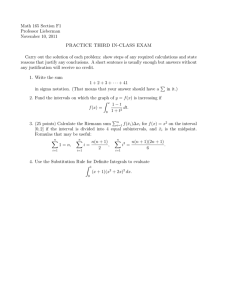
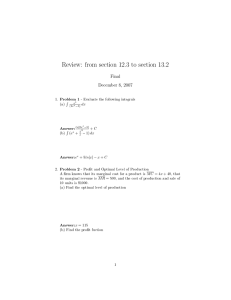
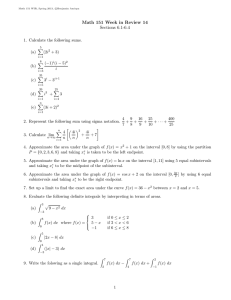
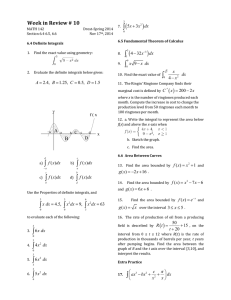
![∈ [ ( ) = ]](http://s2.studylib.net/store/data/010601535_1-6f70cc477c07d559090667d6567ce3dc-300x300.png)

